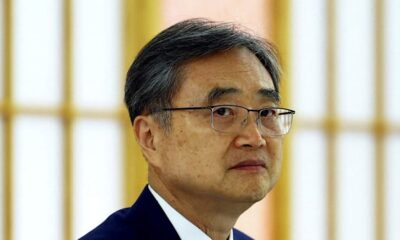Health
Singapore’s Healthcare Reform: The Shift to a Principal Doctor Model

In a significant shift aimed at improving patient care, Singapore’s Minister for Health, Ong Ye Kung, announced a new healthcare model that designates a single “principal doctor” for patients with complex medical conditions. This reform, introduced in September 2023, seeks to streamline care and enhance coordination among specialists, addressing the challenges faced by an ageing population with multiple health issues.
Challenges in Current Healthcare Delivery
Patients admitted for acute issues, such as a hip fracture, often require input from various specialists. For instance, a patient with diabetes and hypertension might see an orthopaedic surgeon, an endocrinologist, a cardiologist, and a neurologist. This fragmented approach can leave patients confused about who is in charge of their care. As Minister Ong pointed out, patients frequently find themselves repeating their symptoms to multiple doctors, leading to an overwhelming array of prescriptions and treatment options.
The new model aims to address these issues by consolidating care under a single physician who possesses a broad knowledge base across various specialties. This approach is particularly crucial given the rising obesity rates in Singapore, which now stand at approximately one in eight adults, according to the latest National Population Health Study. The prevalence of chronic diseases, including heart conditions and dementia, is also a growing concern.
Implementation Challenges Ahead
While the proposed changes are welcomed by many in the medical community, including Dr. Jeremy Lim, there are significant challenges to implementation. Key among these are “turf issues” that arise when specialties overlap. For instance, both general surgeons and gastroenterologists can perform certain procedures, which may lead to conflicts regarding patient care. When disagreements occur between the principal doctor and specialists, determining liability could pose additional complications.
Another concern is the legal framework surrounding the responsibilities of the principal doctor. The current system has established clear guidelines for resident physicians, but similar standards will need to be developed for hospital clinicians operating under this new model. The Singapore Medical Council will play a crucial role in defining these responsibilities to ensure accountability.
Incentives also play a critical role in this transition. Currently, specialists in Singapore earn different incomes based on their respective fields, which could influence the attractiveness of the new broad-based clinician roles. A commentary published in the Annals of the Academy of Medicine Singapore revealed that only 326 of Singapore’s 17,326 medical practitioners are accredited in Internal Medicine, considered ideal for managing multi-condition patients. Enhancing the career paths and compensation for hospital clinicians will be essential to attract more doctors to this model.
Building Public Trust and Acceptance
Public perception presents another hurdle. Many Singaporeans view specialists as the primary authority in healthcare, often expecting them to integrate various treatment aspects. For this new model to succeed, it is crucial to foster trust in the principal doctor system as a means of enhancing care, rather than as a measure to relieve specialists of their workload.
Singapore has successfully elevated the status of family physicians over the past two decades through increased funding and recognition of their vital role in preventive care. A similar strategy will be necessary to establish the credibility of hospital clinicians. This will involve comprehensive public education campaigns and robust data demonstrating that hospital clinicians can improve patient outcomes.
Research from other countries indicates that integrated care models can lead to shorter hospital stays and reduced costs without compromising the quality of care. As Singapore grapples with the realities of an ageing population and rising chronic health issues, the need for a more integrated healthcare approach becomes increasingly urgent.
The challenges ahead may be daunting, but the potential benefits of implementing the principal doctor model could lead to a more efficient healthcare system that better serves the needs of Singapore’s citizens. With careful planning and execution, this reform could become a cornerstone of Singapore’s healthcare landscape.
-

 Business5 months ago
Business5 months agoKenvue Dismisses CEO Thibaut Mongon as Strategic Review Advances
-

 Lifestyle5 months ago
Lifestyle5 months agoHumanism Camp Engages 250 Youths in Summer Fest 2025
-

 Sports5 months ago
Sports5 months agoDe Minaur Triumphs at Washington Open After Thrilling Comeback
-

 Sports5 months ago
Sports5 months agoTupou and Daugunu Join First Nations Squad for Lions Clash
-

 Top Stories5 months ago
Top Stories5 months agoColombian Senator Miguel Uribe Shows Signs of Recovery After Attack
-

 Health5 months ago
Health5 months agoNew Study Challenges Assumptions About Aging and Inflammation
-

 World5 months ago
World5 months agoASEAN Gears Up for Historic Joint Meeting of Foreign and Economic Ministers
-

 World3 months ago
World3 months agoSouth Korea’s Foreign Minister Cho Hyun to Visit China This Week
-

 Business5 months ago
Business5 months agoOil Prices Surge Following New EU Sanctions on Russia
-

 Entertainment5 months ago
Entertainment5 months agoDetaşe-Sabah Violin Ensemble Captivates at Gabala Music Festival
-

 Business3 months ago
Business3 months agoStarling Bank Plans Secondary Share Sale, Targeting $5.4 Billion Valuation
-

 Entertainment5 months ago
Entertainment5 months agoBaku Metro Extends Hours for Justin Timberlake Concert









